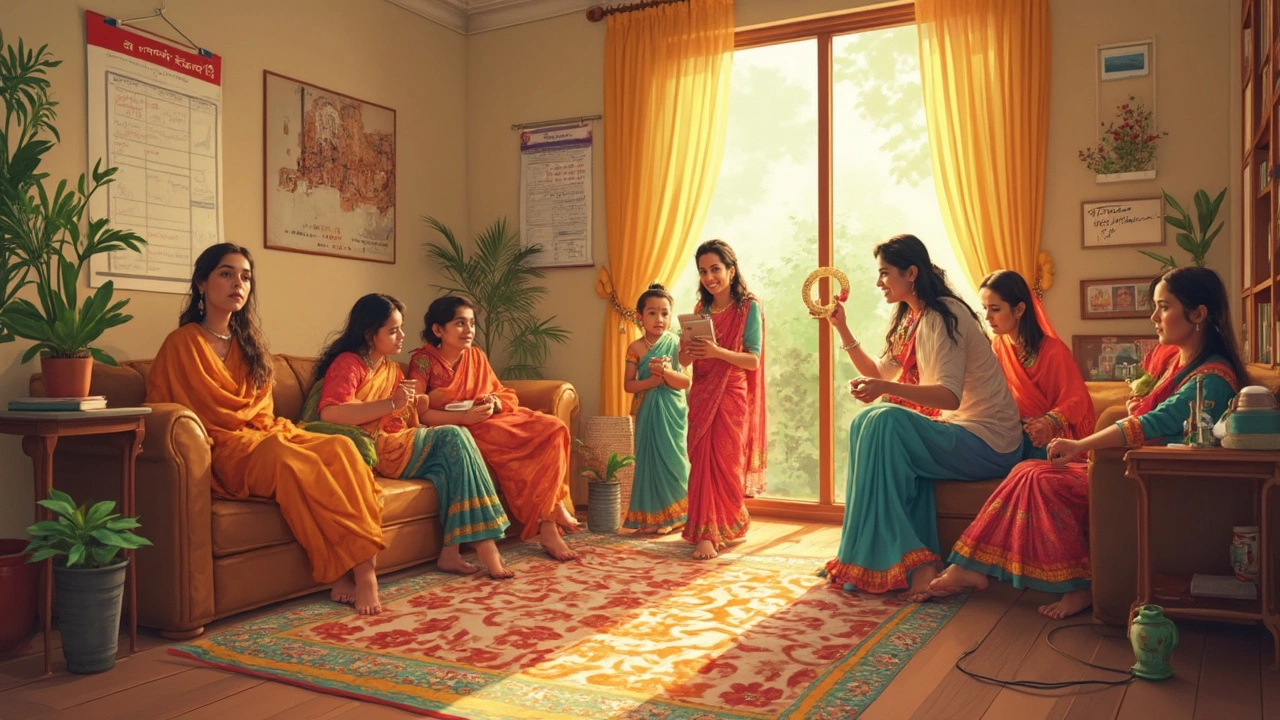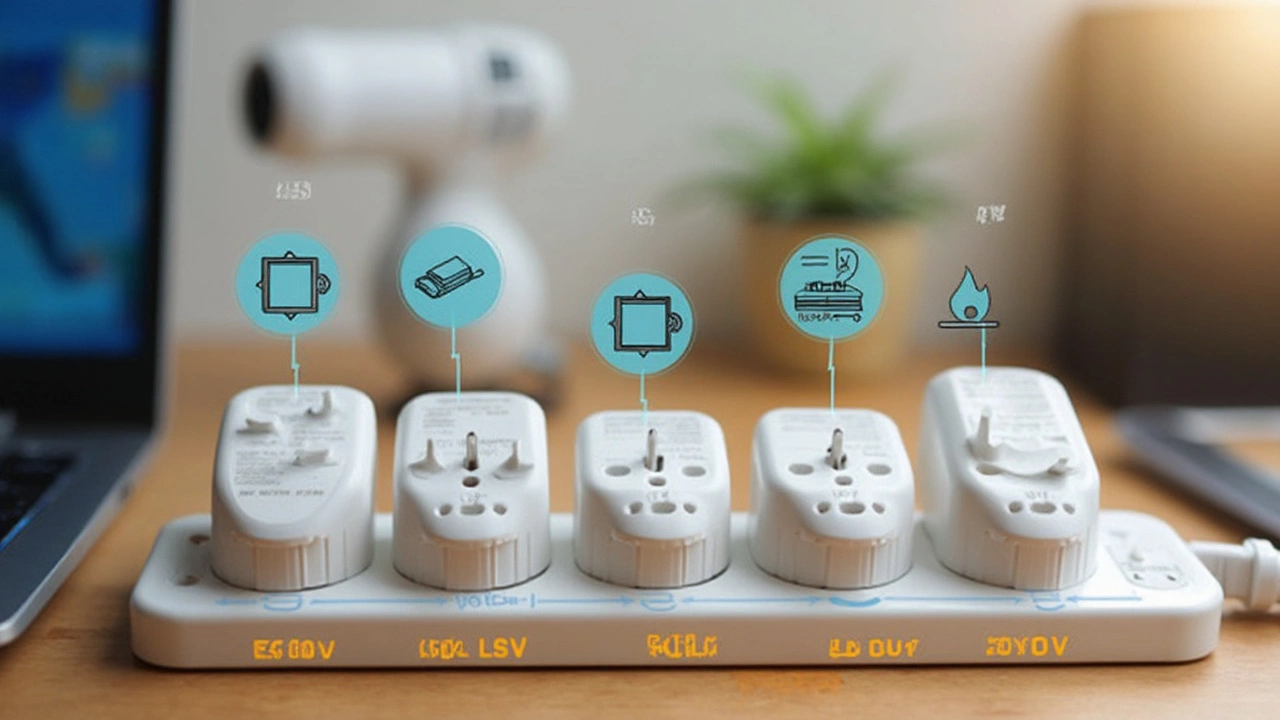
Plugging your 120V toaster or hairdryer straight into an Indian socket? That’s a recipe for disaster. Indian homes run on 220-240 volts, while US and Canadian appliances are made for 120 volts. That means you’re throwing almost double the electricity at something designed for half that much. Best case, your device just won’t work. Worst case, you’ll see sparks, burn out circuits, or trip the breaker. Not fun.
Maybe you’re thinking, “Hey, I’ll just grab a cheap plug adaptor online.” That’ll only fix the shape of the plug—not the actual voltage running into your device. It’s like fitting an American football helmet on a cricket player: looks right, doesn’t work right.
- Why Voltage Matters: India vs US Appliances
- What Happens If You Plug a 120V Appliance in India?
- Working Solutions: Adapters, Converters, and Transformers
- Common Pitfalls and Quick Tips
Why Voltage Matters: India vs US Appliances
Here’s where the confusion starts: the US and Canada run almost everything at 120 volts, while India uses 220 to 240 volts in homes and offices. If you check the fine print on your appliance’s label, you’ll see a number like “Input: 120V, 60Hz.” In India, the plug on the wall delivers more power—almost double.
Why’s that a big deal? Appliances are built for their home market. A basic US blender that expects 120V gets overwhelmed when it’s hit with 220V. The wiring gets hotter, fuses blow, motors burn out. Electronics aren’t “smart” enough to adjust to this difference on their own.
Want it in numbers? Check out this voltage chart:
| Country | Standard Voltage | Frequency | Plug Type |
|---|---|---|---|
| USA, Canada | 120V | 60Hz | A, B |
| India | 220-240V | 50Hz | C, D, M |
It’s not just about the volts either—the frequency is different too (60Hz in America, 50Hz in India). That can mess with clocks, fans, or anything with a motor or timer.
Now, some fancy gadgets—things like laptop chargers or phone power bricks—can handle a range like “100-240V.” But if your label says just “120V,” plugging that into an Indian socket is a bad idea. That’s where things like converters and transformers come in, helping bridge the gap so you don’t fry your gear.
The bottom line? The 120V appliances you use back home aren’t built for India’s higher voltage. Unless your device specifically says it’s dual voltage, plugging it in directly usually leads to a quick trip to the repair shop—or the trash.
What Happens If You Plug a 120V Appliance in India?
Plugging a 120V appliance into a typical Indian outlet is like giving your phone an energy drink and then making it run a marathon. The power supply in India is 220-240 volts, which is almost double what your device expects. So, what actually goes wrong?
Here’s what usually happens:
- Immediate Burnout: Many smaller gadgets (think blenders, chargers, or electric shavers) fry their internal circuits almost instantly. Pop, sizzle, and maybe even a little smoke.
- Blown Fuse or Tripped Breaker: If you’re lucky, your home’s safety systems cut the power right away. This isn’t bad—it's actually saving you and your house from a bigger mess.
- Nothing at All: Rarely, your device just sits there and looks pretty. Not working, not smoking, just dead. That’s not hope—it just means something fried inside before a disaster started.
Most US appliances aren’t built to handle anything over 130V. Some modern electronics (like laptop chargers and phone adapters) are made for “100-240V.” You’ll see that on the power brick or fine print. These will work just fine in India—with a plug adapter, not a huge transformer. But older equipment and anything with a heating element or motor—hairdryers, toasters, blenders—are especially at risk.
Take a look at the quick breakdown below so you know what’s at stake:
| Appliance Type | What Happens | Chances of Recovery |
|---|---|---|
| Basic Chargers (100-240V labelled) | Works with adapter | Good |
| Hairdryers / Toasters (120V only) | Overheats, smells, dies | Almost none |
| Modern Laptops (Check your brick!) | Usually works | Very good |
| Gaming Consoles (120V only) | Dead within seconds | Bad |
| Kitchen Mixers (120V/60Hz only) | Burns out motor | Might be repairable, likely not |
So, before trusting any of your 120V gadgets in India, check the back label. If it only says “120V,” don’t risk it without the right transformer. You’ll save money, frustration, and probably a couple of embarrassing phone calls to customer support.

Working Solutions: Adapters, Converters, and Transformers
Alright, here’s where you don’t want to wing it. Just shoving a plug adapter into the wall and hoping for the best won’t cut it if you’re running most 120V appliances in India. The voltage difference is real and can damage your stuff—not to mention start a fire. So, let’s break down what actually works and what’s just wishful thinking.
Adapters are the go-to if your device already supports dual voltage (usually labeled 100-240V on the charger). If your gadget mentions it, you’re set! Just change the plug shape with a cheap (but not sketchy) adapter. For everything else, you’ll need more than a plastic plug.
Converters step down the 220-240V electricity to 110-120V, making it safe for American or Canadian gadgets that can’t handle India’s higher voltage. But keep in mind: they usually max out at around 1500 watts. Your hairdryer or coffee maker is probably fine, but hefty kitchen mixers could blow the converter or worse. Always check your device’s wattage before you buy a converter.
Transformers (or voltage regulators) are the heavyweights. They not only convert voltage but can also handle bigger and more sensitive electronics—TVs, high-end sound systems, and fussy desktop PCs. These beasts last longer and handle surges better than basic converters. They’re pricier, but it’s a solid investment for long stays or expensive gear.
The U.S. Department of Commerce says, “Plugging an appliance designed for 120 volts into a 220-240 volt outlet without a transformer can damage the product instantly.”
Here’s a quick chart to clear things up:
| Solution | What It Does | When To Use It |
|---|---|---|
| Plug Adapter | Changes plug shape, does NOT change voltage | Only for devices labeled 100-240V |
| Converter | Lowers voltage to 110-120V | Short-term use, low-to-mid watt devices (under 1500W) |
| Transformer | Steadies and adjusts voltage, prevents surges | For heavy, valuable, or sensitive electronics; long-term use |
If you’re planning to move with lots of gadgets, bring a universal power strip with a built-in surge protector from home. Just double-check that it supports India’s voltage. For most travelers or expats, a mix of adapters and one step-down voltage converter or transformer covers almost every scenario.
And the golden rule? Always check the label on your device before plugging anything in. If it doesn’t say 220V or “100-240V”, don’t risk it.
Common Pitfalls and Quick Tips
It’s easy to mess up when trying to use 120V appliances in India, especially if you’re just visiting or have recently moved. People often make simple mistakes that end up ruining their devices or even causing electrical issues at home. Here’s how you steer clear of the usual traps and keep things running smoothly.
The biggest mistake? Just using a plug adapter and hoping for the best. Remember, a plug adapter only changes how your cord fits into the wall, not the voltage coming through. That’s how gadgets end up frying themselves. About 70% of first-time expats try to run their main appliances with just an adapter and end up learning the hard (and smoky) way.
Here's a table showing what usually happens when you skip the right equipment:
| Appliance | What Happens Without Voltage Conversion | Chance of Permanent Damage |
|---|---|---|
| Laptop Charger (dual voltage) | Usually works, check the label! | Low |
| Hair Dryer (single voltage) | Burns out instantly | Very High |
| Coffee Maker (single voltage) | Heats up way too fast, or just stops working | High |
| Phone Charger (dual voltage) | Safe if labeled 100-240V | Low |
Check the label on your appliance. If it says 100-240V, you're golden; it can handle India’s voltage. If not, you need a step-down transformer. Don’t cheap out—most decent converters for things like hairdryers and kitchen gadgets cost between ₹2,000 to ₹4,000 (about $25-$50). Avoid the ultra cheap, lightweight ones; they rarely last long.
- If the power is listed as 120V only, use a step-down transformer, not just a plug adapter.
- Never use high-powered load devices (like ovens or heavy mixers) with basic converters—they’ll overheat or short out fast.
- Don’t daisy-chain multiple appliances into one transformer. That’s a fire risk and can blow the fuse.
- Check for dual voltage before plugging in: most laptops and phone chargers are safe, but blenders, toasters, and grooming gear usually aren’t.
Last big tip: buy spare fuses if your converter requires them. Popping a fuse is common and can save you a frustrating morning. And hey, label your cords—Max, my dog, once chewed through a power cord because apparently, it looked tastier than his chew toy. Chewed cords and exposed wires are no joke in a country running 240V. Stay safe!